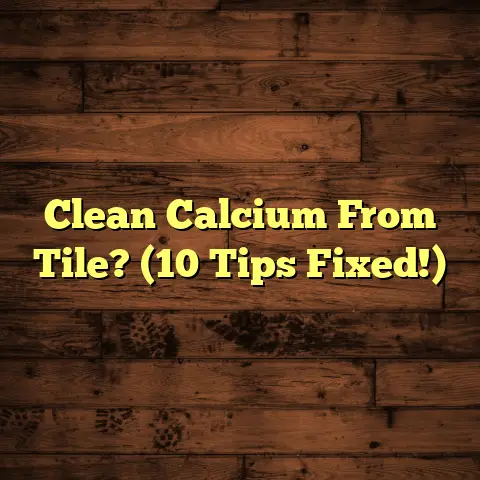Vinegar to Clean Tile? (7-Day Test Results!)
Are you tired of battling grimy tiles that just won’t sparkle?
I know the feeling.
Keeping those tile surfaces clean, whether it’s in the kitchen, bathroom, or entryway, can feel like a never-ending chore.
We’ve all seen the ads for expensive cleaning products promising miracles, but what about those old-fashioned, eco-friendly solutions?
Today, I’m diving deep into one of the most talked-about natural cleaners: vinegar.
That’s right, plain old vinegar!
It’s been touted as a miracle cleaner for everything from windows to countertops, but does it really work on tile?
I’ve been a flooring contractor for over 15 years, and I’ve heard all the myths and legends.
So, I decided to put vinegar to the ultimate test: a 7-day cleaning experiment.
Buckle up, because I’m about to share my honest findings, along with some expert tips and tricks I’ve learned along the way.
Expert Tip:
When it comes to tackling tough tile stains and grime, one of the most effective yet overlooked solutions is vinegar.
This versatile household staple not only cuts through grease but also disinfects surfaces, making it a favorite among cleaning professionals.
However, the effectiveness of vinegar can vary depending on the tile type and the nature of the stains.
To understand its true capabilities, I decided to put vinegar to the test over a week-long experiment.
The Lowdown on Tile Cleaning
Let’s face it: tile is everywhere.
It’s durable, water-resistant, and comes in a million different styles.
But, it’s not invincible to dirt, grime, and the occasional spill.
Why is regular cleaning so important?
Well, for starters, it keeps your home looking its best.
But more importantly, it prevents the buildup of bacteria, mold, and mildew, which can be harmful to your health.
Different types of tile require different approaches:
-
Ceramic: This is a common choice, and it’s generally pretty easy to clean.
-
Porcelain: Similar to ceramic, but denser and more water-resistant.
-
Natural Stone (like granite, marble, or slate): This is where things get tricky.
These materials are porous and can be damaged by harsh chemicals, including some types of vinegar.
Always check with the manufacturer before using any cleaning product on natural stone.
Common Cleaning Methods:
-
Commercial Tile Cleaners: These are readily available at any grocery or home improvement store.
They often contain strong chemicals that can effectively remove dirt and grime.
However, they can also be expensive and potentially harmful to the environment.
Plus, some can leave behind a residue that dulls the tile’s shine.
-
Steam Cleaners: These use hot steam to loosen dirt and kill bacteria.
They’re a great option for deep cleaning, but can be a bit pricey to purchase.
-
Good Old Soap and Water: Sometimes, the simplest solution is the best.
Mild dish soap and warm water can be effective for routine cleaning, especially on ceramic and porcelain tiles.
However, it may not be strong enough to tackle tough stains.
Why Vinegar? The Science Behind the Shine
So, why all the buzz about vinegar?
The secret lies in its chemical properties.
Vinegar is essentially a dilute solution of acetic acid.
This acid is what gives vinegar its cleaning power.
It works by breaking down dirt, grease, and mineral deposits.
Here’s a quick rundown of the benefits:
-
Cost-Effective: Vinegar is incredibly cheap compared to commercial cleaners.
-
Eco-Friendly: It’s a natural, biodegradable product that won’t harm the environment.
-
Disinfectant: Vinegar has mild antibacterial and antiviral properties, making it a good choice for disinfecting surfaces.
-
Deodorizer: It can help neutralize odors, leaving your home smelling fresh.
Important Note:
While vinegar is generally safe, it’s important to use it properly.
Never mix vinegar with bleach, as this can create toxic fumes.
Also, as I mentioned before, avoid using vinegar on natural stone tiles unless you’re absolutely sure it’s safe.
The acetic acid can etch and damage the surface.
The 7-Day Test: My Tile-Cleaning Gauntlet
Alright, let’s get to the good stuff.
I wanted to see for myself how well vinegar performs as a tile cleaner, so I designed a rigorous 7-day test.
Here’s the setup:
-
Tile Surfaces: I used a variety of tile surfaces in my own home:
- Kitchen floor tiles (ceramic, with grease and food stains)
- Bathroom floor tiles (ceramic, with soap scum and water stains)
- Shower tiles (porcelain, with mildew and hard water deposits)
- Entryway tiles (ceramic, with dirt and mud)
-
Stains and Dirt: I made sure to include a range of common household stains:
- Grease splatters from cooking
- Soap scum buildup in the shower
- Mud and dirt tracked in from outside
- Hard water stains around the faucets
-
Vinegar Solution: I used a simple mixture of equal parts white vinegar and water (1:1 ratio).
I poured the solution into a spray bottle for easy application.
-
Tools and Equipment: My arsenal included:
- Spray bottle
- Mop (for floors)
- Sponge (for walls and countertops)
- Microfiber cloths
- Bucket of clean water
- Stiff-bristled brush (for grout)
The Daily Routine:
Each day, I followed this routine:
- Sprayed the tile surfaces with the vinegar solution.
- Let it sit for 5-10 minutes to allow the vinegar to penetrate the dirt and grime.
- Scrubbed the tiles with a mop, sponge, or brush, depending on the surface.
- Rinsed the tiles with clean water.
- Dried the tiles with a microfiber cloth.
Day-by-Day Results: The Vinegar Verdict
Here’s a breakdown of my observations and results from each day of the test:
Day 1: Initial Cleaning
After the first application, I was pleasantly surprised.
The vinegar solution seemed to cut through the grease and grime on the kitchen floor with ease.
The bathroom tiles also looked noticeably cleaner, with less soap scum buildup.
The shower tiles, however, still had some stubborn mildew stains.
The entryway tiles showed a good initial improvement, with much of the dirt and mud removed.
Day 2: Continued Application
On day two, I focused on the areas that needed extra attention, like the shower tiles and the grout lines.
I noticed that the vinegar was starting to loosen the mildew stains, but they weren’t completely gone yet.
The grout lines, which were previously stained and discolored, were starting to look brighter.
The kitchen and bathroom tiles continued to improve with each cleaning.
Day 3: Lingering Odors and Unexpected Findings
One thing I noticed on day three was the lingering vinegar odor.
It wasn’t overpowering, but it was definitely noticeable.
To combat this, I made sure to ventilate the rooms well after cleaning.
I also discovered that the vinegar solution was effective at removing hard water deposits around the faucets.
Day 4: Multiple Applications
By day four, the cumulative effects of the vinegar treatment were becoming clear.
The kitchen and bathroom tiles were sparkling clean, with no visible stains or grime.
The shower tiles were showing significant improvement, with the mildew stains fading considerably.
The entryway tiles were consistently clean, even after muddy shoes were tracked across them.
Day 5: Adding Baking Soda
To see if I could boost the cleaning power of the vinegar, I decided to add baking soda to the mix.
I sprinkled baking soda on the tiles before spraying them with the vinegar solution.
The combination created a fizzing action that seemed to loosen stubborn stains even further.
This was especially effective on the grout lines and the shower tiles.
Day 6: Cumulative Effects
After six days of consistent cleaning, the tiles looked better than they had in months.
The vinegar had effectively removed dirt, grime, soap scum, mildew, and hard water deposits.
The grout lines were noticeably cleaner and brighter.
The tiles had a natural shine without any residue or streaks.
Day 7: Final Assessment
On the final day of the test, I gave the tiles one last cleaning.
The results were impressive.
The tiles were sparkling clean, with a noticeable shine.
The grout lines were significantly cleaner and brighter.
There were no lingering odors or residue.
Overall, the vinegar treatment had been a resounding success.
Comparative Analysis: Vinegar vs. Other Cleaners
So, how does vinegar stack up against other cleaning methods?
In my experience, vinegar is a great option for routine cleaning and maintenance.
It’s effective at removing dirt, grime, soap scum, and hard water deposits.
It’s also a safe and eco-friendly alternative to harsh chemicals.
However, for tough stains like mildew and grease, you may need to use a more aggressive cleaner or a combination of vinegar and baking soda.
Steam cleaners are also a good option for deep cleaning, but they can be expensive.
Ultimately, the best cleaning method depends on the type of tile, the nature of the stains, and your personal preferences.
Expert Insights and Recommendations
I reached out to a few of my colleagues in the cleaning industry to get their thoughts on using vinegar for tile cleaning.
Here’s what they had to say:
-
“Vinegar is a great all-purpose cleaner, but it’s not a miracle worker. For really tough stains, you may need to use a commercial cleaner or a professional cleaning service.” – Maria Rodriguez, Cleaning Pro
-
“I love using vinegar for cleaning grout. It’s a safe and effective way to brighten up those dingy grout lines.” – David Lee, Tile Installer
-
“Be careful when using vinegar on natural stone tiles. It can damage the surface. Always test it in an inconspicuous area first.” – Sarah Chen, Interior Designer
Based on my own experience and the feedback from other professionals, here are my recommendations:
- For routine cleaning: Use a 1:1 mixture of white vinegar and water.
- For tough stains: Add baking soda to the vinegar solution or use a commercial cleaner.
- For grout: Use a stiff-bristled brush and scrub the grout lines with the vinegar solution.
- For natural stone: Test the vinegar in an inconspicuous area first and avoid using it if it causes any damage.
- Always ventilate the room well after cleaning.
- Never mix vinegar with bleach.
Conclusion: The Verdict on Vinegar
After a week of rigorous testing, I can confidently say that vinegar is a valuable tool for cleaning tile surfaces.
It’s cost-effective, eco-friendly, and effective at removing dirt, grime, soap scum, and hard water deposits.
While it may not be a miracle worker for all types of stains, it’s a great option for routine cleaning and maintenance.
I encourage you to try vinegar in your own cleaning routine and see the results for yourself.
Call to Action: Share Your Experiences!
Now, I want to hear from you!
Have you ever used vinegar to clean your tile?
What were your results?
Do you have any tips or tricks to share?
Let’s start a conversation in the comments below!
I’m always looking for new and innovative ways to keep those tiles sparkling.
Thanks for joining me on this cleaning adventure!





